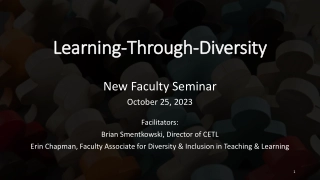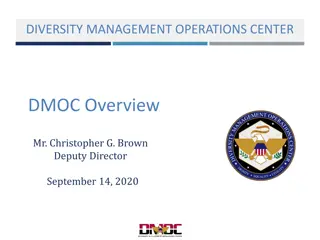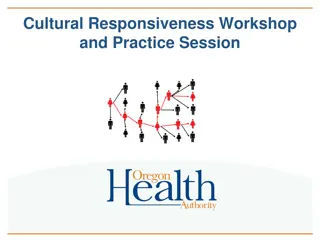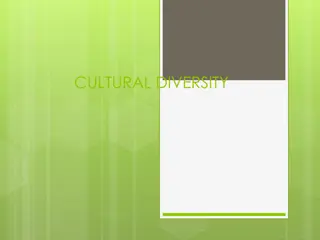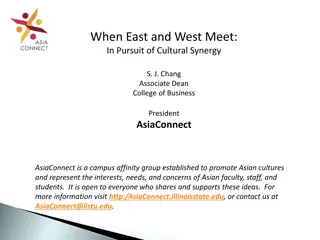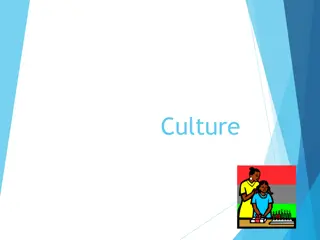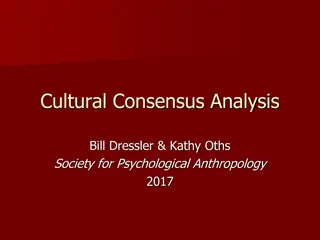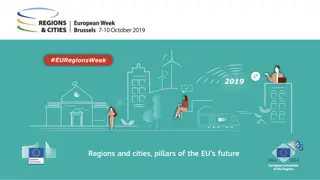Cultural Diversity in Teaching and Learning
Explore the impact of cultural strengths on education, examining how learned patterns and behaviors shape interactions and learning styles. Discover the concept of contextuality in different cultures and learn steps to become culturally sensitive in teaching practices.
Download Presentation

Please find below an Image/Link to download the presentation.
The content on the website is provided AS IS for your information and personal use only. It may not be sold, licensed, or shared on other websites without obtaining consent from the author.If you encounter any issues during the download, it is possible that the publisher has removed the file from their server.
You are allowed to download the files provided on this website for personal or commercial use, subject to the condition that they are used lawfully. All files are the property of their respective owners.
The content on the website is provided AS IS for your information and personal use only. It may not be sold, licensed, or shared on other websites without obtaining consent from the author.
E N D
Presentation Transcript
What do you see in this photo? Photo by Dawn Ellner (CC BY 2.0)
Artifacts and Behaviors Beliefs Values ELEMENTS OF CULTURE Norms Underlying Assumptions
culture learned patterns or sets of group behavior and values imprinted on individuals, beginning at birth. These patterns, both conscious and unconscious, frame the context for individuals to perceive time and space, to interact and associate with one another, and to establish modes of perceiving and learning about the world. Anthropologist Edward T. Hall (1977, 1984, 1992) identified populations both here and abroad with similar patterns of cultural context and clustered them on a continuum from High to Low, signifying the importance or intensity of these patterns within certain ethnic and gender groups.
Multicontext world (Hall, 1960 s) National origin cultures that exhibited learned preferences (cultural contexts) that influence how One interacts and associates with others Uses living space Perceives concepts of time Processes information Responds to various teaching and learning styles Performs academically
Contextuality Low Context Cultures (LC) High Context Cultures (HC) predominantly northern European ethnic groups predominantly ethnic minorities Females Males focus on streams of information that surround an event, situation or interaction in order to determine meaning from the context in which it occurs. filter out conditions surrounding an event or interaction focus as much as possible on words and objective facts. High use of non-verbal signals to contextualize meaning Emphasis on words to supply meaning Indirect communication Direct communication
Steps to becoming culturally sensitive Write you own cultural autobiography Learn about other cultures Learn how to be sensitive to other cultures in your classes and teach to your students cultural strengths. improving achievement by teaching diverse students through their own cultural filters Low context / individuated High context / integrated Multicontext
Brainstorming pedagogies Take a moment for some cultural reflection Open to a blank sheet of paper, and create 2 columns, label one Individuated or Low context and label the other column integrated or High context . Brainstorm as many pedagogies you can think of for each column How do the columns compare? Does one have more activities? What does that mean for you? For your students? Find someone with the other cultural context, and compare your lists. If you are multicontextural, find another MC
Gallery walk On each easel is an assignment Decide if this assignment is best for an integrated student (HC), an individuated student (LC) or in between (MC). Then provide suggestions on how this assignment can be better designed to reach all?
In a small group: Discuss and evaluate: This exercise in terms of Context Diversity; and how would you revised it to broaden the Multicontextual framework. Critique the evaluations relative contextual framework with each other. Offer suggestions for improvement See the Learning Community Questions page to help in this exercise.
Sharing your Revisions Now, share how your group evaluated this exercise and how you revised it to broaden the Multicontextual framework. Critique the evaluations relative contextual framework with each other. Offer suggestions for improvement See the Learning Community Questions page to help in this exercise.
By teaching mostly within only one cultural framework, we are not reaching in ways that incorporate a diversity of cultural strengths. Subsequently, we create learning environments that privilege some kinds of learning and underserve or even repress others. This is one of the reasons some cultural groups have greater success and retention rates in college than others (p 129)
Facilitating learning across cultures has to do in great part with developing pedagogies, relational dynamics, and assignments that promote a healthy balance of resonance and dissonance with a diversity of learners (p 130)
Final thought Where would you place the geosciences, as a whole, in this continuum? What are some of the most distinctive qualities of the geosciences in relation to teaching and learning? Do the cultural norms of the geosciences center primarily in an integrated, individuated, or balanced framework? How might students from different cultural framworkes experience the geosciences? How might your own teaching within the geosciences evolve toward a more balanced foundation of cultural frameworks?
Many faculty still teach from a content-driven framework, yet for most students, learning happens more from a process-driven framework (p 131)


